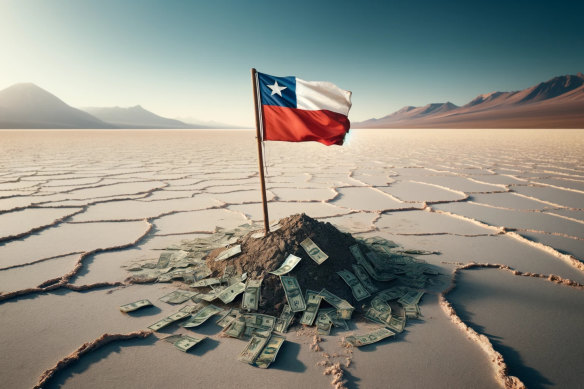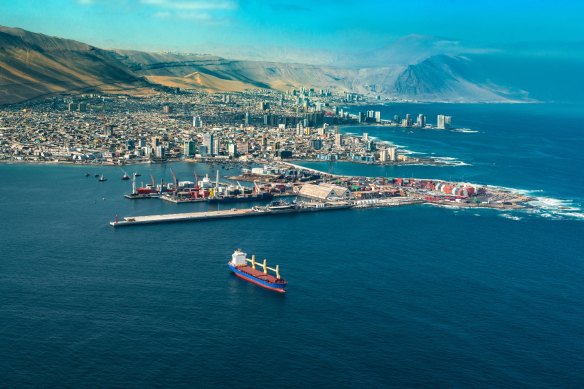- Sponsored
- Business
- Companies
- Bulls N' Bears
Pan Asia sets sights on lithium brines at Chilean salt flats
Brought to you by BULLS N’ BEARS
By Michael Philipps
With a huge landholding in one of the world’s biggest lithium-producing countries, Pan Asia Metals is looking to add lithium brine production to its books after picking up the Tama Atacama project in Chile.
Situated in the Pampa del Tamarugal basin in the northern part of Chile’s Atacama Desert, the operation takes in six project areas that extend about 290km north-to-south and covers about 1600 square kilometres.

Pan Asia Metals is searching the salt flats of the Atacama Desert in Chile for lithium brines.
While historic mining in the Atacama dates back to the beginning of last century when saltpetre was a target, the search for copper in the area later emerged to become the country’s biggest export and lithium has more recently been gaining momentum.
And the company’s signing of the formal documentation to acquire Tama Atacama back in January, clearly grabbed the attention of the ASX market as its stock immediately jumped from 12.5c to touch 26c for an increase of 108 per cent.
Surface samples at the site have delivered elevated lithium results up to 2200 parts per million. Of the 177 samples taken at the project, 56 returned elevated lithium values greater than 270ppm at an average grade of about 700ppm.
Management has highlighted the Pink lithium prospect in the Tarapacá region of northern Chile as its priority target. It believes Pink has the potential for deeper lithium-rich brines, which are hosted in consolidated to semi-consolidated sedimentary/evaporite horizons, from about 250m down to 700m.
And at near-surface, the company has identified the potential for lithium to be hosted in clays and evaporative layers.
Groundwater investigations at the Pink, Pozon, Dolores South and Dolores North brine prospects confirmed that saline groundwater zones generally correspond with highly-elevated lithium in surface salt crusts, indicating relatively shallow saline aquifers. Certain areas of the salars host elevated levels of boron, potassium and magnesium – elements considered to be commonly associated with lithium – with many areas immediately to the west having played host to historic nitrate mining.
“PAM’s South American and South East Asian projects are located in very low cost environments.”
Pan Asia Metals chairman and managing director Paul Lock
The sheer size of the combined operations makes it one of the biggest lithium brine projects in South America. Pan Asia is in discussions with geophysics and drilling service providers and plans to begin drilling at the Pink project as soon as possible.
A strategic advantage at Tama Atacama is altitude.
Management says at some 800m to 1100m, it is one of the lowest brine projects in its South American peer group, has major road and energy infrastructure passing by or through all holdings and it is only about 40km to 60km from the coast. The popular coastal holiday destination of Iquique is about 75km by road from the Pink prospect and has a deep-water port and commercial airport.
Importantly for the proposed lithium brine production, the project sits in a hyper-arid environment, with little to no rainfall and extreme evaporation conditions.
Pan Asia Metals chairman and managing director Paul Lock said: “The low-cost philosophy often falls on deaf ears during the price-cycle high, but the importance of a project’s actual or potential cost curve position becomes very apparent at the commodity price-cycle low. PAM’s South American and South East Asian projects are located in very low cost environments and proximal to lithium chemical and EV/Li-ion battery manufacturing. Both projects are set apart from their peer groups on a number of levels, offering strategic advantages which are difficult to emulate.”
Management says lithium has come off a three-year low of about US$13,000 (AU$19,743) a tonne from December through February and despite the price-cycle low, low-cost projects still pumped out profits.
Macquarie’s Metals and Mining research team recently published a cost curve identifying low-cost sources of lithium, which included South American brines as the lowest-cost and high-grade lepidolite. However, the company adds that the lithium source is not the only factor worth considering as environment and proximity are also important.
The salt flats of Chile host two of the world’s biggest lithium operators – SQM and Albemarle – in South America’s celebrated Atacama region.
SQM produces lithium carbonate at its Salar del Carmen plant, which is close to the northern Chilean port city of Antofagasta, from solutions with high lithium concentrations extracted from the Salar de Atacama.
Albemarle began to produce lithium carbonate at its La Negra facility from lithium brines back in 1984. In 1998, a lithium chloride plant in La Negra was brought on-stream where production capacity has been expanded to meet the needs of the growing demand.
Dubbed the “Lithium Triangle”, the area between Chile, Bolivia and Argentina, contains about 54 per cent of the world’s lithium reserves. The United States Geological Survey says Chile alone has 9.6 million tonnes of lithium reserves and accounted for 30 per cent of global lithium production last year.

Pan Asia Metals’ Tama Atacama project is near the Chilean port city of Iquique.
In April last year, the Chilean Government announced a broad restructuring of the local lithium industry that will see it partner with local leaseholders. Private companies producing lithium in Chile must now adopt the direct extraction method in order to link up with the government and operate in the country.
Direct extraction refers to a growing suite of technologies that directly extract lithium salt from brine through processing rather than the existing method that allows the sun to dry out the lithium brine after it has been distributed into massive ponds.
The brine is a salty solution sitting below the earth’s crust, generally below salt lakes. The raw brine is about three times as salty as sea water and the salt-rich solution has a high mineral concentration that includes lithium and a host of other minerals.
While it is still early days for Pan Asia and its Chilean brine venture, the government has released a policy framework allowing companies to apply for a special lithium operation contract. About 1200sq km of Pan Asia’s tenements meet the framework requirements.
Plans are already in place for a drill campaign aimed at identifying lithium-bearing aquifers at depth. Once identified, management has its sights set on defining an initial mineral resource before the end of the year.
Pan Asia is also seeking to raise up to $2 million through a private placement with professional and sophisticated investors through an offer of 13c per share. The raise includes $165,000 in board participation, with 15.4 million shares on offer and funds will be used to conduct field work and geophysics at Tama Atacama, in addition to initial reconnaissance drilling at the site.
While it is the company’s first foray into lithium brines, it is no stranger to exploring for the important battery metal.
Just today, Pan Asia revealed it had identified a big lepidolite pegmatite swarm measuring 800m long and 350m wide at its Reung Kiet lithium project in Thailand. Hand-held X-ray fluorescence analysis of 46 rock chip samples from the swarm returned highly-elevated pathfinder elements including rubidium and caesium.
The company has identified a mineral resource estimate of 14.8 million tonnes at a grade of 0.45 per cent lithium oxide, or about 164,500 tonnes of lithium carbonate equivalent, at Reung Kiet.
Pan Asia says it will continue to explore its Thailand tenements as it looks to take advantage of being one of the only lithium explorers in Southeast Asia and it is in pole position to supply the region’s burgeoning battery industry due to its geographical location. Management also plans to use funds from its placement on testwork and a prefeasibility study (PFS) at Reung Kiet, in addition to developing a mineral resource at the nearby Bang I Tum prospect, just a few kilometres north of its major Thailand site.
But the market will no doubt keep a close eye on what the company can deliver at its new Chilean operation where it holds a sizeable chunk of land in an area with known lithium brine production. One of the driest places on Earth may just become a river of hope.
Is your ASX-listed company doing something interesting? Contact: mattbirney@bullsnbears.com.au